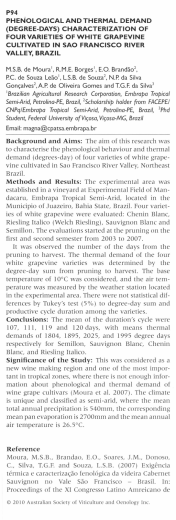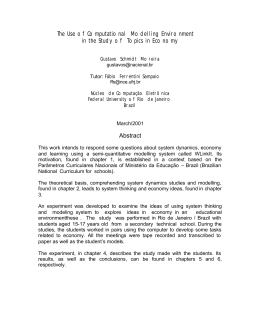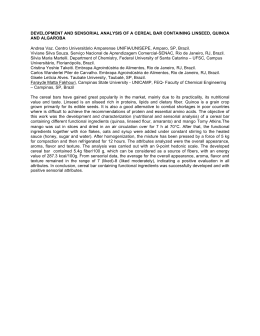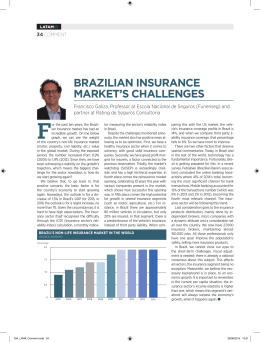Phenological and thermal demand (degree-days) characterization of four varieties of white grapevine cultivated in Sao Francisco River Valley, Brazil MagnaSoelmaBeserra de Moura1, Rita Mércia Estigarríbia Borges 1, Elieth Oliveira Brandão2, Patrícia Coelho de Souza Leão1, Luciana Sandra B. de Souza2, Nadja Pollyanna da Silva Gonçalves2, Ana Patrícia de Oliveira Gomes, Thieres George Freire da Silva3 1Brazilian Agricultural Research Corporation, Embrapa Tropical Semi-Arid, Petrolina-PE, Brazil 2Scholaf'shipholder from FACEPE/CNPq/EmbrapaTropical Semi-Arid,Petrolina-PE, Brazil 3Phd Student, Federal University of Viçosa, Viçosa-MG, Brazil Email: [email protected] Background and Aims The aim of this research was to characterize the phenological behavior and thermal demand (degrees-day) of four varieties of white grapevine cultivated in Sao Francisco River Valley, Northeast Brazil. Significance of Study this is considered as a new wine making region and one of the most important in tropical zones, where there is not enough information about phenological and thermal demand of wine grape cultivars (Moura et. aI, 2007). The climate is unique and classified as semi-arid, where the mean of total annual precipitation is 540mm, the corresponding mean pan evaporation is about 2700mm and the mean air temperature is 26.5°C. Methods: The experimental area was established in a vineyard at Experimental Field of Mandacaru, Embrapa Tropical Semi-Arid, located in the Municipio of Juazeiro, Bahia State, Brazil. Four varieties of white grapevine were evaluated: Chenin Blanc, Riesling Italico (Welch Riesling), Sauvignon Blanc and Semillon. The evaluations started at the pruning on the first and second semester from 2003 to 2007. Results: It was observed the number of the days from the pruning to harvest. The thermal demand of the four white grapevine varieties was determined by the degree-day sum from pruning to harvest. The base temperature of 10°C was considered, and the air temperature was measured by the weather station located in the experimental area. There were not statistical differences by Tukey's test (5%) to degree-day sum and productive cycle duration among the varieties. Conclusions the mean of the duration's cycle were 107, 111, 119 and 120 days, respectively to Semillon, Sauvignon Blanc, Chenin Blanc, and Riesling Italico. Their thermal demand was, respectively, 1804, 1895,2025, and 1995degree-days. References MOURA, M. S. B. ; BRANDAO, E. O. ; SOARES, J. M. ; DONOSO, C. ; SILVA, T. G. F.; SOUZA, L. S. B. . Exigência térmica e caracterização feno lógica da videira Cabemet Sauvignon no Vale São Francisco - Brasil. 10: XI CONGRESSO LATINO AMERICANO DE VITICULTURA Y ENOLOGIA, 2007, Mendonza. CONGRESSO LATINO AMERICANO DE VITICULTURA Y ENOLOGIA, 2007. CD-Rom. 8th International Symposium on Grapevine Physiology and Biotechnology, Adelaide, Australia 211
Download









